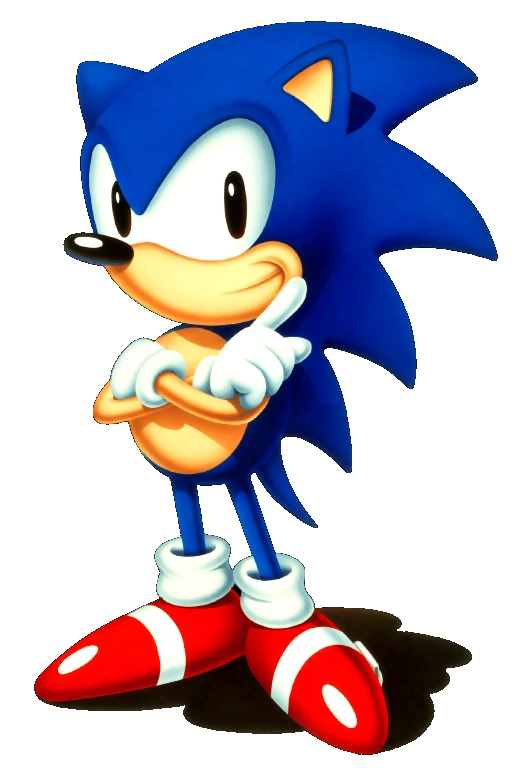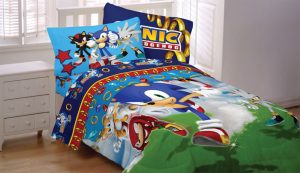 Sega’s famous mascot, the little blue hedgehog with an attitude and big sneakers, turns a quarter century old this month. That’s a pretty mean feat for any company symbol, particularly a video game one. Even so, it’s perhaps easy to think that Sonic has been in slump for the past decade or so, with a history of questionable titles released on different consoles. It’s also easy to say he’s in decline and blame Sega’s departure from hardware as the starting point of his downfall. And while the drop off in quality of Sonic games is beyond question, it isn’t fair to categorize him simply by software quality or sales. To truly gauge the worth and status of Sonic, we need to take a look at the character himself and his status in pop culture. Doing so raises a question that isn’t nearly as cut and dried as many would think: Is Sonic really in decline?
Sega’s famous mascot, the little blue hedgehog with an attitude and big sneakers, turns a quarter century old this month. That’s a pretty mean feat for any company symbol, particularly a video game one. Even so, it’s perhaps easy to think that Sonic has been in slump for the past decade or so, with a history of questionable titles released on different consoles. It’s also easy to say he’s in decline and blame Sega’s departure from hardware as the starting point of his downfall. And while the drop off in quality of Sonic games is beyond question, it isn’t fair to categorize him simply by software quality or sales. To truly gauge the worth and status of Sonic, we need to take a look at the character himself and his status in pop culture. Doing so raises a question that isn’t nearly as cut and dried as many would think: Is Sonic really in decline?
Think about how I framed that question. I’m referring to Sonic as an overall intellectual property, not solely in regard to his games. I also mentioned Sonic’s status in pop culture. That I could even make such a distinction signifies his transcendence from a mere video game character. Even with his gaming track record since the Dreamcast was discontinued in March of 2001, Sonic has managed to maintain an iconic place in the public eye. Can we honestly say that he is in decline, given the level of popularity he still has? Even when there are no new Sonic games on store shelves or when the latest release is getting panned, Sonic stands smirking in retail stores across the world, waving his finger and selling everything from t-shirts to action figures. In fact, I would go so far as to say that it is his merchandising status that fuels his video game sales and not the other way around.
Of course, we must first recognize the impact that Sonic has had on video gaming and Sega’s fortunes as a company. Since his 1991 debut, the Blue Blur has starred in over 70 games, which have collectively sold over 140 million copies to the tune of $5 billion in sales. That’s something no other industry character, save for that plump plumber (who’s older and has appeared in more than twice as many games) and the legendary Pac-Man, have even come close to accomplishing. It was the first Sonic The Hedgehog that put the Genesis into many homes, and its sequel helped put Sega over the top and topple Nintendo’s monopoly. Along the way, the hedgehog outsold and outlasted a flurry of furry platforming mascot copies that watered down the genre and pushed 16-bit gamers into the waiting arms of 3D. Sonic himself took his sweet time to ease into the third dimension in proper form, but when he finally did, it was to tune of over two million copies and the best-selling Dreamcast game of all time.
That event is where most people tend to draw a line between the end of the “good” Sonic games and the start of the “bad” ones, and with the poor reception of those releases over the past decade, many gamers wonder why Sega still even bothers. Why not just retire Sonic? The answer involves a lot more than just software. For Sega, Sonic is no longer just a video game character; he’s a perpetual revenue stream, and for good reason. While the Blue Dude with ‘Tude has stumbled on game machines, he’s been a unqualified success in multiple other areas. His Archie Comics series has been released continuously for 23 years and holds the Guinness world record as the longest-running video game-related comic, stores like Toys ‘R Us continuously have Sonic toys on the shelves, Walmart and Target sell Sonic blankets and bedspreads, he has a movie in the works, and his latest cartoon series (his fourth overall) has just been picked up for a second season. No other video game character, not even the great Mario himself, has tapped into so many different aspects of pop culture, and I believe that this is what has given Sonic his longevity. Hell, there’s an official website dedicated to his merchandise alone.
It is this level of exposure that has allowed Sonic to endure. None of the pretenders to the mascot throne that have come and gone over the past 25 years have managed to maintain such a degree of popularity. Bubsy, Aero the Acrobat, Crash Bandicoot, Blinx, Conker – all of them have struggled to even maintain their viability as video game characters, and none have ever had any real merchandising chops. Spyro the Dragon got a reprieve thanks to the Skylanders toy line but has never been its star. Most of these characters have been forgotten, while Sonic The Hedgehog continues to make Sega money outside of gaming.
Of course, there’s a reason for that as well. The truth is that none of those would-be mascots had the good fortune from birth that Sonic had. A series of factors early in his life were influential in ensuring his lasting appeal. First, as the creation of one of the most talented and celebrated game design houses in the industry, Sonic was in great hands from his conception. Naoto Oshima, Hirokazu Yasuhara, and Yuji Naka – all creative geniuses in their own right – converged to produce the game that would topple an empire. The level of urgency and destiny surrounding Sonic was immense, as the entire company’s retail strategy would be designed around him. A perfect storm of character and level design and programming was something that hardly happens in game development, and it was such a special event that even Sega itself would struggle to reproduce the results.
Another early blessing was that Sonic was pushed hardest in Sega’s largest market, North America. The character underwent some needed redesign to make him more Western-friendly, and he soon became the face of the company. Additionally, bundling his initial outing with the Genesis hardware helped propel sales and move Sega out of the console industry doghouse where it had languished with all of Nintendo’s competition, the result of that company’s abusive marketing and licensing tactics. 1992’s Sonic The Hedgehog 2 then solidified Sega as a gaming powerhouse with the greatest market share. Though it would eventually lose that position, Nintendo’s hold on gaming would never be the same again, and the industry was blown wide open for other competitors to succeed. It was at this time that Sonic was at his highest popularity, and it was here that he became a household name. He’s never looked back, either, regardless of how bad some of his games have been. Since he first zoomed onto television screens in 1991, Sonic has enjoyed his best software sales in the U.S. Currently, half of the franchises lifetime sales come from that region.
 Sega of America’s retail success with Sonic was the result of brilliant marketing, including the first (near) worldwide software launch. The marketing push that was placed behind the new star was huge, extending well beyond the Genesis, and Sega managed to plaster his face on every imaginable product to incredible effect. During the first half of the ‘90s, Sonic was everywhere, and this immense exposure helped ingrain him in the public consciousness, beyond that of Sega gamers and video game fans in general. It was this event that elevated his persona and allowed him to expand beyond a single industry. With video games, comics, cartoons, and retail products Sonic was now much more than a mascot; he was an icon. Only a year after his debut, Sega’s snarky spokesman was more recognized among children than Mickey Mouse, a position held by Nintendo’s Mario just a year earlier. That stardom has never truly waned. Hell, he even has a gene and a Chevy named after him.
Sega of America’s retail success with Sonic was the result of brilliant marketing, including the first (near) worldwide software launch. The marketing push that was placed behind the new star was huge, extending well beyond the Genesis, and Sega managed to plaster his face on every imaginable product to incredible effect. During the first half of the ‘90s, Sonic was everywhere, and this immense exposure helped ingrain him in the public consciousness, beyond that of Sega gamers and video game fans in general. It was this event that elevated his persona and allowed him to expand beyond a single industry. With video games, comics, cartoons, and retail products Sonic was now much more than a mascot; he was an icon. Only a year after his debut, Sega’s snarky spokesman was more recognized among children than Mickey Mouse, a position held by Nintendo’s Mario just a year earlier. That stardom has never truly waned. Hell, he even has a gene and a Chevy named after him.
While the Sonic franchise continues to be the most recognizable money maker for Sega, it could very well be that Sega feels compelled to release Sonic games simply to maintain his name, sort of “feed the beast,” if you will. Whereas marketing is used to push video game sales, Sonic seems to thrive from the inverse. It is the games that fuel his persona, not the other way around. That is what keeps him popular, and that is why we’re celebrating his 25th anniversary, even with all the missed opportunities. Just look at the circumstances of this birthday. The last great Sonic game was Sonic Generations, and that was released to celebrate his 20th anniversary. Another character would wither and die with from that kind of neglect. Sonic instead got a new cartoon and toy line. He’s simply now on another level, and we as gamers need to stop looking at him as merely a game character. He’s been much more than that for Sega for quite some time.
Hopefully, his success will remain constant and translate into software of quality that matches those that made him so famous in the first place. The potential is there, as is the fanbase and brand name. All we need now is for Sega to once again reach for the golden ring.
Happy birthday, Sonic!
Sources
- Boutros, D. (2006). A detailed cross-examination of yesterday and today’s best-selling platform games. Gamasutra.
- Gaudiosi, J. (2014, July 9). Sonic The Hedgehog still running fast for Sega. Fortune.
- Hester, B. (2016). Sonic The Hedgehog’s long, great rocky history. Polygon.
- Hussain, T. (2016, Feb. 10). Sonic The Hedgehog movie coming in 2018, mixes live-action and animation. Gamespot.
- Misra, R. (2015). The strange history of how a gene was named “Sonic Hedgehog.” I09.
- Kent, S. & Schwarz, F.D. (1997). Super Mario nation. American Heritage, 48(5), 65-77.
- Woodyard, C. (2011, Jan. 21). Naming Chevrolet Sonic: Think of a hedgehog on wheels. USA Today.
